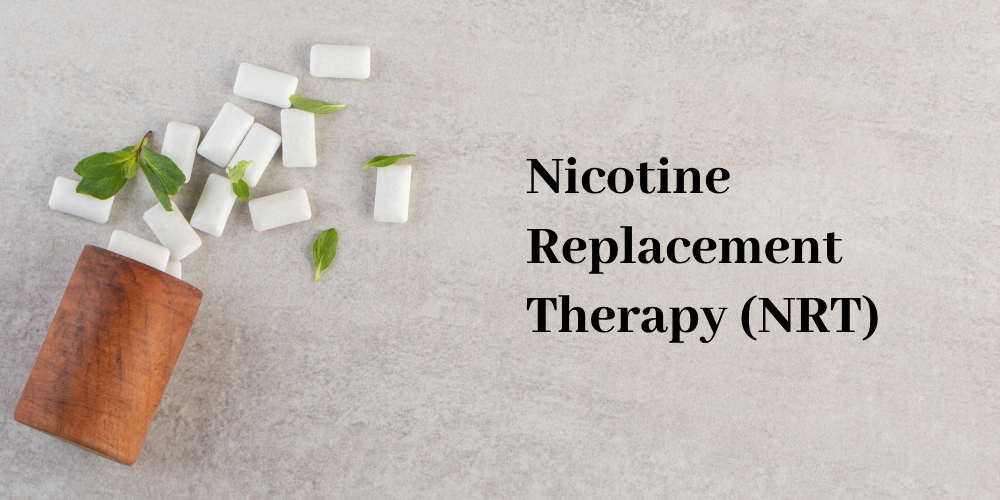
What is Nicotine Replacement Therapy (NRT)?
Nearly about 70% of smokers want to quit, but only about 7% succeed without help. Quitting smoking or vaping is a monumental challenge, and many people struggle against the intense cravings and withdrawal symptoms that accompany it. This is where Nicotine Replacement Therapy (NRT) steps in as a game-changer. NRT offers a pathway to ease the transition from nicotine dependence to a smoke-free life by providing your body with nicotine, minus the harmful chemicals found in cigarettes and e-cigarettes. This helps you manage withdrawal symptoms and reduce smoking cravings.
Imagine starting your day with a nicotine patch, feeling reassured that you have a powerful tool to combat cravings. Or maybe you prefer the immediacy of nicotine gum or lozenges, ready to tackle urges whenever they arise. NRT isn’t just about the physical act of using these products; it’s about taking control of your journey to quit and reclaim your health.
In this article, we’ll get into what NRT is, explore the various forms it takes, and understand its benefits. We’ll also share practical tips to help you maximize NRT. Whether you’re aiming to quit smoking or kick the vaping habit, this comprehensive guide will equip you with the knowledge and confidence to take that crucial first step toward a nicotine-free life.
So, why wait? Let’s jump into the world of Nicotine Replacement Therapy and discover how it can support your journey to quit smoking or vaping. With the right tools and support, you can overcome challenges and embrace a healthier, smoke-free future.
Understanding Nicotine Replacement Therapy
Understanding how NRT works and its various forms can empower you or your loved ones to make informed decisions on the path to a smoke-free life. Let’s explore the different types of NRT, how they work, and their effectiveness based on research. Whether you’re just starting your journey to quit or have faced setbacks before, this guide will provide valuable insights and practical tips to support your efforts.
Various Forms of NRT
There are several forms of NRT available, each catering to different preferences and needs. Here’s a closer look at the most common types:
- Nicotine Patches:
- Mechanism: These patches stick to the skin and deliver a consistent, controlled amount of nicotine over the course of the day.
- Usage: Typically applied to a clean, dry area of skin each morning and worn for 16-24 hours.
- Effectiveness: Research published in the “Journal of the American Medical Association” indicates that nicotine patches can double your chances of quitting compared to going cold turkey.
- Nicotine Gum:
- Mechanism: This gum is chewed to release nicotine, which is absorbed through the lining of your mouth.
- Usage: Chew a piece when you feel a craving, up to 24 pieces a day.
- Effectiveness: According to a study in the “New England Journal of Medicine,” nicotine gum is particularly useful for combating sudden cravings.
- Nicotine Lozenges:
- Mechanism: These lozenges dissolve slowly in the mouth, releasing nicotine as they do.
- Usage: Use one lozenge every 1-2 hours, with a maximum of 20 lozenges per day.
- Effectiveness: The “Addiction” journal reports that nicotine lozenges are effective for individuals who prefer an oral form of NRT.
- Nicotine Nasal Spray:
- Mechanism: The spray delivers nicotine quickly through the nasal lining.
- Usage: Apply 1-2 sprays in each nostril, up to a maximum of 40 times per day.
- Effectiveness: Clinical trials have shown that nasal sprays can help reduce cravings more rapidly than other forms.
- Nicotine Inhalers:
- Mechanism: Inhaled through the mouth, providing a vapor that is absorbed through the mouth and throat.
- Usage: Use as needed, up to 16 cartridges per day.
- Effectiveness: The “American Journal of Preventive Medicine” highlights that inhalers are beneficial for those who miss the physical act of smoking.
Benefits of Using NRT
- Reduces Withdrawal Symptoms:
- Fact: The Centers for Disease Control and Prevention (CDC) notes that NRT can significantly reduce withdrawal symptoms, easing the quitting process.
- Example: John, a 35-year-old smoker, successfully quit using nicotine patches. He found that the patches helped manage his irritability and cravings, making the transition smoother.
- Increases Quit Rates:
- Fact: Studies show that NRT can double the chances of successfully quitting smoking.
- Example: A meta-analysis from “The Cochrane Database of Systematic Reviews” found that people using NRT were 50-70% more likely to quit than those using a placebo.
- Improves Health Outcomes:
- Fact: The World Health Organization (WHO) states that quitting smoking greatly reduces the risk of heart disease, stroke, and lung cancer.
- Example: Maria, a 50-year-old former smoker, used nicotine gum and noticed better lung function and less coughing within weeks of quitting.
Combining NRT with Other Strategies
While NRT is effective on its own, combining it with other quit-smoking strategies can enhance its effectiveness. Here are a few additional methods to consider:
- Behavioral Therapy:
- Benefits: Provides support and strategies to handle triggers and stress.
- Example: Cognitive-behavioral therapy (CBT) can help you develop coping skills and change smoking-related behaviors.
- Support Groups:
- Benefits: Offers a community of people undergoing similar experiences.
- Example: Online forums offer support and motivation from fellow quitters.
- Medication:
- Benefits: Prescription medications like varenicline (Chantix) and bupropion (Zyban) can help reduce cravings and withdrawal symptoms.
- Example: A study published in “The Lancet” discovered that combining NRT with varenicline led to higher quit rates compared to using either treatment alone.
Potential Side Effects of NRT
While generally safe, NRT can cause some side effects. Being aware of these can help you manage them more effectively. Common side effects include:
- Skin Irritation (Patches):
- Solution: Rotate the site of the application and use a non-irritating moisturizer.
- Mouth and Throat Irritation (Gum, Lozenges, Inhalers):
- Solution: Follow proper usage guidelines and avoid swallowing nicotine.
- Nasal Irritation (Nasal Spray):
- Solution: Using a saline spray to soothe nasal passages will help.
- Sleep Disturbances:
- Solution: Remove the patch before bedtime if it affects sleep.
Quitting smoking or vaping is a challenging journey, but with the right tools and support, it’s entirely possible. Nicotine Replacement Therapy (NRT) provides a safer way to manage withdrawal symptoms and cravings, offering a crucial step toward a smoke-free life. Whether you opt for patches, gum, lozenges, nasal spray, or inhalers, NRT can be an integral part of your quit plan.
Remember, it’s not just about the method you choose but also about the support system you build around yourself. Combining NRT with behavioral therapy, support groups, and possibly medication can significantly enhance your chances of quitting for good. Take the first step today and give yourself the gift of a healthier, smoke-free life. You’ve got this!




